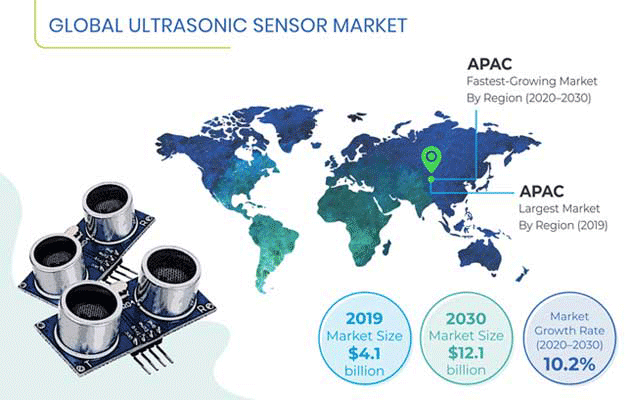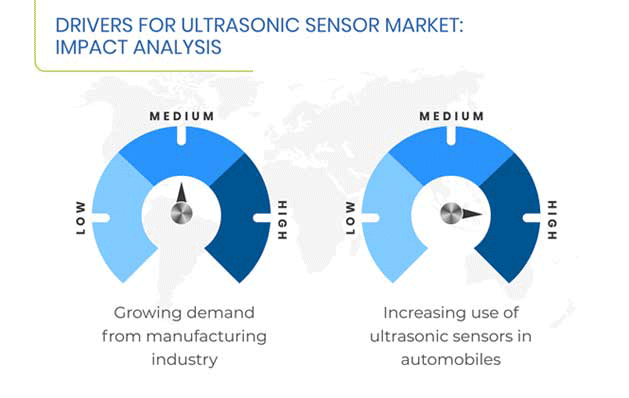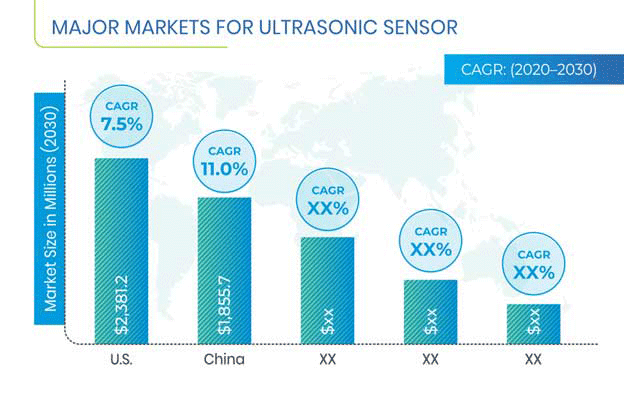Report Code: 11856 | Available Format: PDF | Pages: 171
Ultrasonic Sensor Market Research Report: By Type (Range Measurement, Proximity Detection), Application (Level Measurement, Distance Measurement, Object & Pallet Detection, Loop Control, Diameter Measurement), End User (Food & Beverage, Automotive, Healthcare, Agriculture, Industrial) - Global Industry Share, Growth Analysis, Forecast to 2030
- Report Code: 11856
- Available Format: PDF
- Pages: 171
- Report Description
- Table of Contents
- Market Segmentation
- Request Free Sample
Market Outlook
The ultrasonic sensor market size was $4.1 billion in 2019, and it is expected to reach $12.1 billion by 2030, while progressing at a CAGR of 10.2% during 2020–2030. Geographically, the Asia-Pacific (APAC) region is expected to register the fastest growth in the coming years. This will be on account of the mushrooming demand for automation in industries, burgeoning population, and surging focus toward smart agriculture in the region, especially in India and China.

Factors Governing Ultrasonic Sensor Market
Currently, the ultrasonic sensor industry is observing the trend of burgeoning demand for autonomous mobile robots (AMRs). Owing to the rising technological developments and growing emphasis on improving the efficiency, operational capacity, and production output, the adoption of AMRs is significantly increasing in the medical, oil & gas, electronics, and automotive industries year-over-year (YoY).
Ultrasonic sensors are integrated into AMRs for detecting obstacles and determining the distance between two objects. For instance, Toposens GmbH developed an ultrasonic sensor for range perceptions in robotics and autonomous driving applications in 2019.
The manufacturing sector uses ultrasonic sensors to measure water level in tanks, the diameter of the roll, height, and distance, and loop control. The increasing usage of sensors in the manufacturing sector is a key growth driver for the ultrasonic sensor market.
Further, the increasing industrial production in developing countries has boosted the demand for these sensors, especially in level measurement applications. For instance, industrial production in Turkey in September 2019 had grown by nearly 3.4% year-on-year (YoY).
The booming demand for industrial automation is a key opportunity witnessed in the market for ultrasonic sensors. Owing to the Industry 4.0 initiative, there will be a considerable demand for automation in several industrial processes in the future.
Moreover, manufacturers are increasingly adopting automation solutions to increase their efficiency and productivity and augment their revenue. Ultrasonic sensors play a vital role in industrial automation as they make the products automatic and intelligent.

Segmentation Analysis of Ultrasonic Sensor Market
The proximity detection category, under the type segment, held the larger share in the market for ultrasonic sensors in 2019. This was due to the heavy usage of ultrasonic proximity sensors in the food and beverage processing sector. Under the range measurement category, within the same segment, the through-beam sensor sub-category accounted for the largest share in 2019. This was because of the large-scale usage of these sensors for level monitoring of tanks and counting objects that are difficult to detect.
During 2020–2030, the object & pallet detection category, within the application segment, is expected to grow at the fastest pace in the ultrasonic sensor market. This is ascribed to the rising requirement for these sensors in driverless cars for detecting obstacles on the road, surging need for pallet detection in the food & beverage industry, and the flourishing packaging sector.
Geographical Outlook
The Asia-Pacific (APAC) region generated the highest revenue in the ultrasonic sensor industry, and it is expected to advance at the highest growth rate in the coming years. The key factors fueling this growth are the expanding manufacturing sector and the booming automobile production, primarily in India, China, and Thailand.
The region is also experiencing a notable rise in the demand for smart farming equipment, due to the presence of large arable land here, particularly in India. These devices need to be equipped with ultrasonic sensors to ensure their proper functioning. Companies such as Microsoft Corporation, Agstack Technologies Pvt. Ltd., and IBM Corporation, are leveraging artificial intelligence (AI)-based technologies in agricultural activities across India, to meet the demand for better smart farming equipment.

| Report Attribute | Details |
Historical Years |
2014-2019 |
Forecast Years |
2020-2030 |
Market Size by Segments |
Type, Application, End User |
Market Size of Geographies |
U.S., Canada, Germany, France, U.K., Italy, Russia, China, Japan, India, South Korea, Brazil, Mexico, Argentina, Turkey, South Africa, U.A.E., Egypt |
Explore more about this report - Request free sample
Recent Strategic Developments of Major Ultrasonic Sensor Market Players
The ultrasonic sensor market is fragmented with the presence of numerous players in the market. Some of the major players operating in the market are Pepperl+Fuchs AG, Siemens AG, Honeywell International Inc., OMRON Corporation, Rockwell Automation Inc., KEYENCE CORPORATION, SICK AG, Balluff GmbH, ifm electronic gmbh, Banner Engineering Corporation, and Baumer Holding AG. The key players in the market are focusing on product launches, mergers & acquisitions, and partnerships to increase their presence in the market.
For instance, in July 2019, Pepperl+Fuchs AG launched low temperature sensor that can operate in low temperature of -25° Celsius. This sensor can be used for cold storage applications and mobile equipment in outdoor applications.
Ultrasonic Sensor Market Size Breakdown by Segment
The ultrasonic sensor market report offers comprehensive market segmentation analysis along with market estimation for the period 2014–2030.
Based on Type
- Range Measurement
- Through beam sensor
- Retro-reflective sensor
- Proximity Detection
- Proximity sensor
- 2 point proximity switch
Based on Application
- Level Measurement
- Distance Measurement
- Object & Pallet Detection
- Loop Control
- Diameter Measurement
Based on End User
- Food & Beverage
- Automotive
- Healthcare
- Agriculture
- Industrial
Geographical Analysis
- North America
- U.S.
- Canada
- Europe
- Germany
- France
- U.K.
- Italy
- Russia
- Asia-Pacific
- China
- Japan
- India
- South Korea
- Latin America (LATAM)
- Brazil
- Mexico
- Argentina
- Middle East and Africa (MEA)
- Turkey
- South Africa
- U.A.E.
- Egypt
Want a report tailored exactly to your business strategy?
Request CustomizationWant an insight-rich discussion with the report author?
Speak to AnalystOur dedication to providing the most-accurate market information has earned us verification by Dun & Bradstreet (D&B). We strive for quality checking of the highest level to enable data-driven decision making for you
Our insights into the minutest levels of the markets, including the latest trends and competitive landscape, give you all the answers you need to take your business to new heights
With 24/7 research support, we ensure that the wheels of your business never stop turning. Don’t let time stand in your way. Get all your queries answered with a simple phone call or email, as and when required
We take a cautious approach to protecting your personal and confidential information. Trust is the strongest bond that connects us and our clients, and trust we build by complying with all international and domestic data protection and privacy laws